Great Synagogue, Lutsk
| Great Synagogue of Lutsk | |
|---|---|
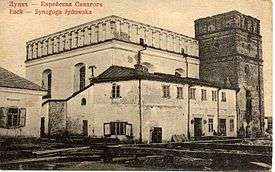 | |
| Basic information | |
| Location |
|
| Status | Not active |
| Architectural description | |
| Architectural type | Defensive synagogue |
| Architectural style | Renaissance |
| Completed | 1629 |
| Materials | brick |
The Great Synagogue in Lutsk, Ukraine, is a Renaissance building with a tower. Located in the Jewish quarter, it was the religious, educational and community centre of Lutsk (Polish: Łuck) Jews until the invasion of Poland in the Second World War. For a long period, it also served as a defensive building. Partially destroyed in 1942, the synagogue was restored in the 1970s. It is now used as a sports club.
History
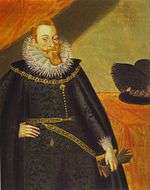
The first records of the Jews in Lutsk date from 1388. Vytautas the Great, Grand Duke of Lithuania, granted privileges for Lutsk Jews. Towards the end of the 15th century, the Jewish community of Lutsk had acquired considerable wealth and influence, and some of its members figured prominently as tax collectors. The Jews were generally engaged in trade but they also owned a brewery and operated guilds. Scientific research indicates that the first brick synagogue was built in second half of the 16th century. It is assumed the synagogue must have been destroyed by fire during the Tatars raid in 1617. The new synagogue was then built on the ruins of the old building.
King Sigismund III Vasa of Poland approved the construction of a new synagogue and school on 5 May 1626. However construction of the synagogue was opposed by its Dominican neighbours. Under Christian rules, synagogues could not exceed a certain height. However, the king confirmed his approval and the Jewish community was victorious. The Dominicans had fallen from favor with the royal court. The height of synagogue was not to exceed that of the Dominican church.
The cube-shaped prayer hall representing architecture of the Italian-Polish Renaissance was the main part of new synagogue. The walls were up to 1.5 m thick. There were two additional sections used by women and for the Jewish school or Yeshiva. A defensive tower containing the arsenal with loopholes was built on the southern corner of the prayer hall according to the wishes the king. The tower formed part of city walls, allowing the synagogue to contribute to defences in addition to its religious and educational roles.
Modern era
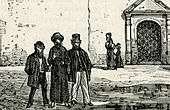
In 1869, the synagogue was damaged by fire. It was restored in 1886. In the 19th century, the way of life of the Jewish community of Lutsk had changed due to the economic and legislative features of Russian Empire. In accordance with the trends of the time, the Jewish community was segmented. New Jewish quarters with synagogues appeared in Lutsk. The old quarters were generally populated by poor Jews living in dirty wooden houses built close to each other. As a result, the main synagogue lost its central role.
The synagogue was shelled during the First World War but not seriously damaged. In reborn Poland the city of Łuck became the capital of the Wołyń Voivodeship (1921–39) and in 1936 the provincial administration contributed funds for its restoration.
World War II
The invading Soviets annexed the city to the Ukrainian SSR in 1939 along with the entire region, an renamed it as Луцьк (Lutsk).[1] After the German attack on the Soviet positions in eastern Poland in 1941, Łuck (German: Ghetto Luzk) became the sight of a pogrom organized by the Ukrainian People's Militia and the synagogue along with the Jewish district were set on fire.[2]
In December 1941 the Łuck Ghetto was established. In August and September 1942, about 17,000 prisoners of the ghetto were killed by Orpo and the Ukrainian Auxiliary Police during a four-day period.[3] The ghetto was liquidated in December 1942. The former main synagogue building stood empty. Many years after the war it was reconstructed as a movie-house and a gym.[4]
Architecture
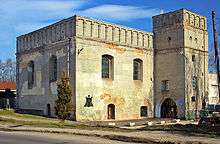
Some researchers and museums have investigated the history of the synagogue. The Nahum Goldmann Museum of the Jewish Diaspora Beth Hatefutsoth located on the Tel Aviv University campus has a model of synagogue. The model reveals architectural details which were lost during the World Wars. The Center for Jewish Art in the Hebrew University of Jerusalem created a 3D-model of the exterior and interior. On 30 May 1995, a commemorative plaque dedicated to the lost Jews was erected on the synagogue wall.
The former synagogue is a cube-shaped building with a tower. Rational clarity, brevity, and restraint in decoration contribute to its Renaissance style. No individual feature the synagogue reveals the building's religious character owing to the public functions of old synagogues. There are unexplored dungeons under the building.
Gallery
 Wartime destruction
Wartime destruction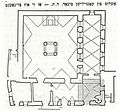 Plan of the Synagogue
Plan of the Synagogue Synagogue (background) and Jesuit roof today
Synagogue (background) and Jesuit roof today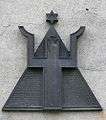 Plaque
Plaque Synagogue today
Synagogue today
| Wikimedia Commons has media related to Great Synagogue in Lutsk. |
| Wikimedia Commons has media related to Churches in Lutsk. |
References
- ↑ Glenn Dynner, François Guesnet, Ghetto of Łuck. BRILL 2015, p.462; Warsaw: The Jewish Metropolis, ISBN 9004291814.
- ↑ YIVO Encyclopedia of Jews in Eastern Europe, Lutsk. Following the Soviet liberation in February 1944, only about 150 Jews returned. By 1959, just 600 Jews were living in Lutsk. The fortified synagogue was turned into a movie theater and later into a sports hall. A residential area was constructed on the site of the Rabbinite and Karaite cemeteries.
- ↑ Yad Vashem, testimony of Shmuel Shulman (Shmulik Shilo), Liquidation of the Jewish inmates of the Łuck labor camp in December 1942 on YouTube. Retrieved July 21, 2015.
- ↑ Dr Pawel Goldstein, Lutsk (Luck) Ghetto. Geni.com. Retrieved 23 July 2015.
- The Great Synagogue of Lutsk by Haim F. Ghiuzeli
- The center of jewish art
- CJA Documentation of Synagogue in Lutsk, Ukraine
- Метельницький Р. Деякі сторінки єврейської забудови Луцька, К.: Дух і літера, 2001, с.85-133 ISBN 966-72-73-16-4
- Grzegorz Rąkowski, Przewodnik po Zachodniej Ukrainie, część I, Wołyń
- Adam Wojnicz. Łuck na Wołyniu. Łuck, 1922, s. 39-42
- Łuck w Słowniku geograficznym Królestwa Polskiego i innych krajów słowiańskich, t. 1, pod red. F. Sulimirskiego, B. Chlebowskiego, W. Walewskiego, t. 5, 1884, s. 778—792
- Stecki T. Łuck starożytny i dziesiejszy. Kraków, 1876, s. 219
- Majer Bałaban. Karaici w Polsce. V. Łuck //Nowe Życie, Warszawa, 1924, № 3, s.323
- Zbigniew Rewski. Z zabytków Wołynia // Znicz, 1936, № 6, s.85-86
- Kraszyńska Fanny. Żydzi Łuccy do końca XVII w. // Rocznik Wołyński. T. VII. Równe, 1938, s.139-178
Coordinates: 50°44′09″N 25°19′07″E / 50.735959°N 25.318699°E